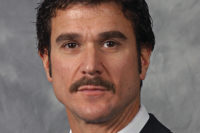
Click on the image for an enlarged view.
The figure here shows a 230-V, single-phase, electrical schematic of a typical commercial refrigeration system. The diagram includes a timer assembly with a defrost termination solenoid (DTS), evaporator fans, defrost heaters, temperature-activated defrost termination/fan delay (DTFD) switch, low-pressure control (LPC), high-pressure control (HPC), compressor contactor assembly, and a compressor/potential relay assembly. The system is drawn in the refrigeration mode.
This exercise will simply show what voltages would be measured across certain points of the schematic if a voltmeter were used in troubleshooting. The diagram will also show where Line #1 (L1) is in relation to Line #2 (L2) for ease of understanding the measured voltages.
Notice that any time the voltmeter probes see both L1 and L2, 230 V will be read on the voltmeter. Any time the voltmeter probes see the same line (L1 to L1 or L2 to L2), 0 V will be read on the voltmeter because there is no voltage difference between the same lines. So, if the service technician can determine where L1 and L2 are in the circuit when voltage troubleshooting, the technician can determine what the voltage should be when using a voltmeter for troubleshooting a circuit.
Notice that sometimes a closed switch and an opened switch will read the same voltage. This is illustrated here when measuring the voltages across the DTFD switches. Again, the service technician has to ask himself where L1 is relative to L2. The technician must also notice that power-consuming devices may read 0 V with a voltmeter if they are not energized and only one line is measured with the voltmeter. This is illustrated across the defrost heater where L2 is measured relative to L2 (itself). The defrost heater is not energized in this case, and is simply a conductor of electricity, not a power consuming device.
Publication date:03/31/2008





